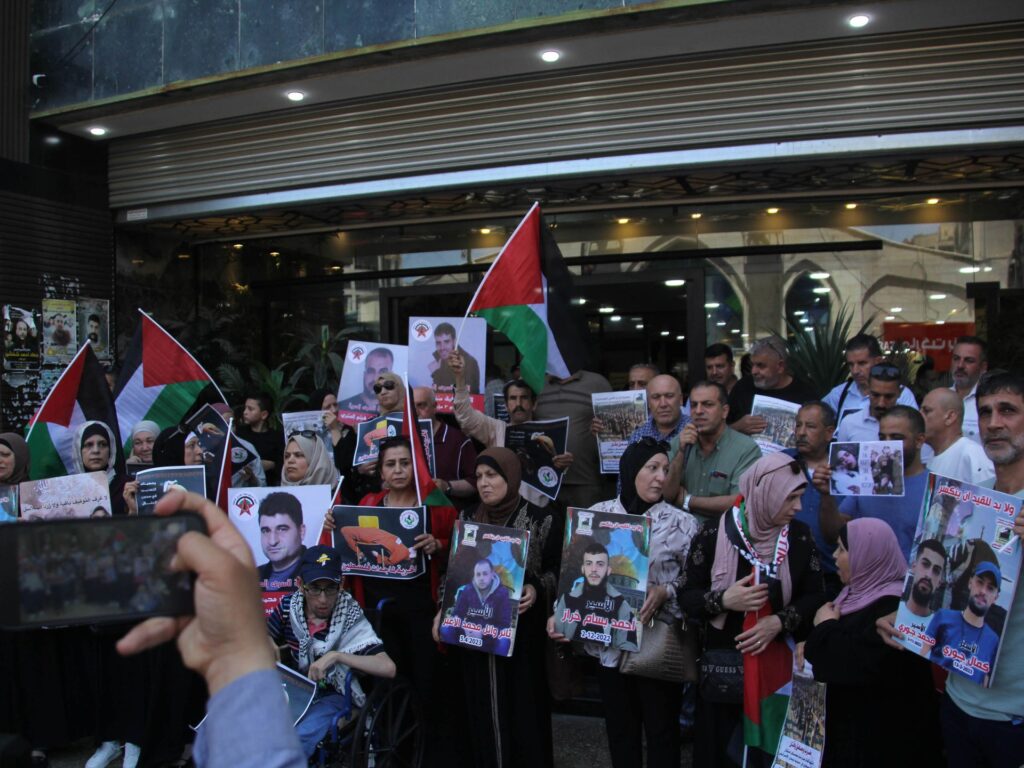Tel Aviv Tribune Net correspondents
Nablus- “Howling” is a way for a Palestinian prisoner to get his food, says recently liberated prisoner Yasar Khalidi, describing what is happening with detainees in the Gaza Strip and Palestinian prisoners in general in Israeli occupation prisons.
This measure not only reflects the extent of the crime that the occupation reached after the seventh of last October, but it is more bitter for the prisoner than the killing itself, which the jailers practiced “with all brutality as well.”
Today, Tuesday afternoon, demonstrations took place in most West Bank cities denouncing the occupation’s violations, organized by institutions concerned with prisoners’ affairs, to shed light on their suffering, especially the Gaza prisoners in the “Sde Teman” and “Anatot” camps, which the occupation established specifically to detain them.
Repression and crimes
In Nablus, the largest city in the northern West Bank, demonstrators organized an event in the city center, carrying Palestinian flags, banners, and pictures showing some of the occupation’s oppressive practices against prisoners and denouncing its crimes, and they chanted in rejection.
In his testimony to Tel Aviv Tribune Net, the freed prisoner, Yasar Khalidi, reported that the occupation had separated Gaza prisoners from other prisoners since the beginning of the war, prevented contact with them, and treated them as numbers printed on their gray uniforms.
He added that the occupation forced them to chant the Israeli national anthem, and also forced them – under torture – to insult Gaza and the leaders of the Islamic Resistance Movement (Hamas), especially its leader, Yahya Sinwar. But the most bitter of them, he continues, is “forcing the prisoners to howl to get their share of food, and after they get down on their knees, they take the plates with their mouths and through their teeth.”
The occupation culminated in all of this with the murders that have targeted dozens of them (about 40 prisoners by its own admission) so far, which no Palestinian or international human rights institution has been able to document due to preventing them from accessing the prisoners in the occupation’s prisons and camps.

Struggle mechanism
All of these crimes and others prompted the Palestinians in the West Bank – as Qaddoura Fares, Minister of the Prisoners’ Affairs Authority (an official body) says, to launch activities denouncing the crimes of the occupation and broadcasting messages, the most important of which is that they represent – as angry masses – the voice of the prisoners and convey their cries to the world that they are being killed, tortured and starving.
He added to Tel Aviv Tribune Net that popular action is a struggle mechanism that supports the prisoner movement in its call to action to pressure the occupation to stop its hand on the prisoners, and that they are now pinning their hopes on expanding the scope of popular action and transforming it into daily action in villages, camps and cities to form a growing and rising popular situation in support of the people and prisoners of Gaza.
Fares described what is happening in the Sde Teman and Anatot camps and various occupation prisons as “atrocities committed in the 21st century.” He said that what is happening in those camps is no less dangerous or worse than what the prisoners face in the rest of the prisons, because the policies and instructions issued from the same mentality of the occupation soldiers and prison security, “The killing of prisoners occurred in the prisons of Ofer, Negev, Megiddo, Sde Teman and others.”
In turn, Muhammad Dweikat, a member of the factional coordination committee in Nablus, believes that these activities aim primarily to mobilize the West Bank street and call on all members of the Palestinian factions and forces to stop the occupation’s violations and confront its bloody policies.
These demonstrations also send messages warning of the ignition and explosion of the situation in the West Bank, before demanding international human rights and humanitarian institutions and the international community to assume its responsibilities regarding what is happening to the prisoners, according to Dweikat.
In addition to the direct killing of prisoners in his camps, Dweikat confirmed that they collected numerous pieces of evidence of the occupation’s crimes, the most important of which was the restriction for days and weeks, which led to the amputation of parts of their bodies, “and they were also left to dogs to maul them.”
unknown fate
Like Nablus, Jenin, Qalqilya, and Ramallah directed their direct messages to the Israeli occupation, and Montaser Sammour, head of the Prisoner’s Club, told Tel Aviv Tribune Net that today’s event was distinguished by its unified message to all the cities of the West Bank, denouncing the crimes of the occupation and supporting the prisoners of Gaza in particular.
Data from the Prisoners’ Affairs Authority and the Palestinian Prisoners’ Club indicate that 18 Palestinian prisoners have been martyred in occupation prisons since October 7, 2023, whose names have been documented.
Dozens of Gazan prisoners were also killed in the occupation camps, bringing the total number of martyrs of the captive movement since 1967 to 255 martyrs, the occupation holding the bodies of 27 of them, according to the same sources.
Although a series of investigations and reports based on testimonies from Gaza detainees revealed horrific crimes of torture that led to the death of dozens of Gaza detainees, the occupation refuses to this day to reveal their identities, apart from the field executions that took place against others.
While Israel has arrested more than 9,000 Palestinians in the West Bank since the war on Gaza, and arrested more than 4,000 Gazan citizens, and has so far released about 1,500 of them, the fate of the rest remains unknown, and the occupation prevents visits to them or any information about them.

